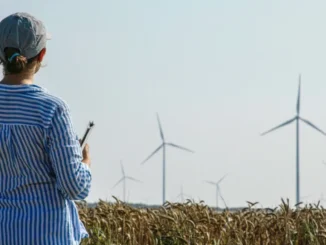
ENB Publishers Note: The world has entered only the fourth Commodities Boom in history, and this one is going to be the biggest because of the energy policies over the last 25 years. See if Alternative Oil and Gas investments are right for your portfolio HERE.
Worried about inflation? You aren’t alone. A survey by Aegon this week showed that 64% of people are concerned about “the impact of rising inflation on their finances”.
Businesses are (very) worried too: the latest quarterly report from the British Chambers of Commerce showed that 59% of companies expect prices to increase over the next three months and 66% said that inflation was a “concern.” Both of those numbers are record highs.
What’s the driver? Some 30% of firms said pay settlements were part of it (we might think of this as good inflation!) but 94% blamed raw materials (bad inflation).
This is in large part about energy prices: wholesale gas prices everywhere have soared – in the UK they are five times what they were a year ago, something that is going to hurt the cash flow of every household.
The Bank of America reckons that the average European household spent about €1,200 on electricity and gas in 2020, a number that, based on current wholesale prices, will rise to €1,850 by the end of 2022 – up by 55%.
Next year is unlikely to be much better. Energy prices will keep on rising because too many governments have jumped the gun on renewables – thinking that we can phase out fossil fuels in favor of deeply unreliable renewable energy significantly faster than we actually can – if indeed we ever can.
The unintended consequences of the rush to decarbonize
This is a decarbonization shock – which one fund manager tells me could even end up causing as much pain as the Opec-driven oil shocks of the 1970s.
There is some relief ahead in, for example, the EU’s better-late-than-never acceptance that natural gas and nuclear energy must be part of the transition. But, for now, at least, prices will keep rising. It is, say analysts at JPMorgan, a simple matter of supply and demand – as ever.
There has been a collapse in investment in oil and gas production – capital spending on new projects is 75% down from its peak. But at the same time global demand for thermal energy sources as a whole has “barely declined” – and the demand for oil just keeps rising.
JP Morgan expects global oil demand to grow by 3.5 million barrels per day in 2022, ending the year both slightly above 2019 levels and at a record high. There will be a new record high in 2023 – there are a lot of record highs in today’s column – more unwanted inflation I’m afraid. JP Morgan’s various research teams forecast oil prices in 2022 to range from $80 to $125 a barrel. The world’s efforts to energy transition are obviously well-intentioned, but good intentions often come at an unexpectedly high price. No exception here.
However, while it is easy to get hung up on gas bills and pump prices – UK politicians have all but forgotten Covid in their eagerness to row about these – rising energy prices may affect your long term wealth way more than they do your short term cash flow.
Could high energy prices spark a stock market crash?
Energy, and the transformation of that energy into goods and services, is the basis of most economic activity. That makes how much it costs and how efficiently we can transform it into absolutely key variables when it comes to stock market valuation.
So much so that you can, says Gavekal’s Charles Gave, use the relationship between oil prices and the S&P 500 to forecast both bull and bear markets. All “structural bear markets in the US have all started when the S&P 500 was significantly overvalued versus energy”, says Gave.
This was the case in 1912, 1929, 1968, and 2000. In each of those years, valuations reflected investors underestimating the future cost of energy and hence overestimating the future profitability of listed companies.
Those who aren’t nervous enough yet might also note that all these bear markets, bar that of 1929-1934, took place with inflation on the up and “lasted as long as inflation endured”.
This makes sense if you think of it in terms of rising energy prices pushing up costs and companies then not being able to add value or improve efficiency fast enough to absorb the costs without raising prices or suffering severely collapsing profits.
The first creates inflation and causes a fall in demand – which hits profits anyway – so either way stocks valued with low energy costs baked into the models begin to look nastily overvalued.
How to invest for higher energy prices
One additional point to make here: for the past few decades, one of the disinflationary impulses in the West has been the cheap goods coming out of China. Those goods were cheap partly because they were made with cheap labour – now getting more expensive – but also because they were made with the cheapest thermal fuel there is – coal.
That’s something that is also shifting. China, keen to reduce pollution and maybe even to decarbonise, aims to get coal down to 20% of its energy mix by 2026. This is far from certain, of course, given the domestic political and economic pressures, but you can see which way things are going.
The key point here is that energy prices matter even more than you might think. Bull markets start when energy is plentiful and cheap (1922, 1949, 1982, 2010 says Gave); bear markets start in times when it is not – times like these.
The investment implications are clear: energy stocks performed very well last year and they will probably do the same this year, but their strength may well be reflected in serious weakness elsewhere. You should hedge the former with the latter.
The simplest way to get exposure to oil and gas in the UK is with an exchange-traded fund, such as the iShares S&P Commodity Producers Oil and Gas ETF (LSE: SPOG). Otherwise, there is the TB Guinness Global Energy Fund, which is all about old energy, or if you want to hedge your energy bets a little look at the BlackRock Energy and Resources Income Trust (LSE: BERI), which is about 33% invested in old energy, or the diversified Temple Bar Investment Trust (LSE: TMPL) with 15% (which I hold, and which is also one of the holdings in the MoneyWeek model portfolio of investment trusts).



